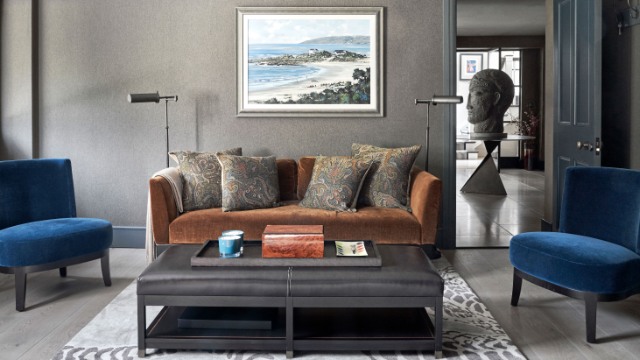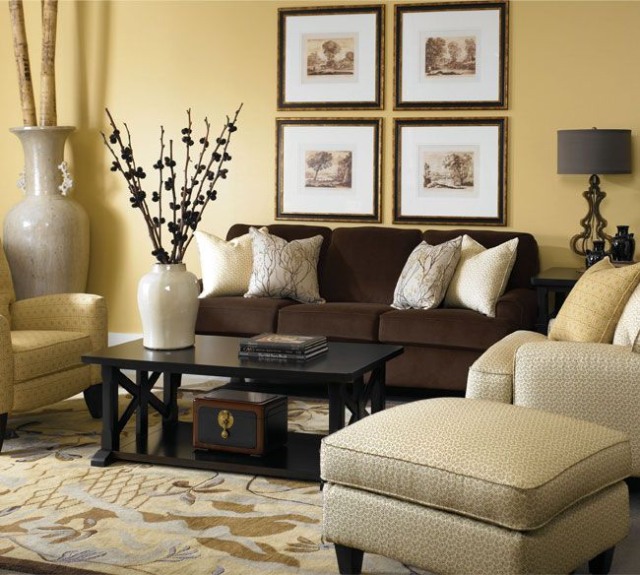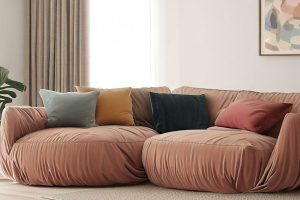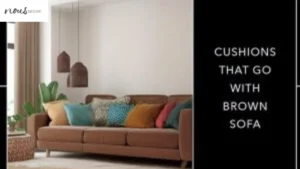Choosing the right Colour Scheme For Living Room With Dark Brown Sofa can seem daunting, but it doesn’t have to be. With the right tips, you can create a space that looks warm and inviting. I’m here to share my knowledge on how to select colors that will accentuate your dark brown sofa while creating an aesthetically pleasing look for your living room.
We’ll cover topics such as considering the room’s natural light, choosing complementary colors, incorporating patterns and textures, adding visual interest with accessories, creating unity with a focal point, utilizing a color wheel, and experimenting with different combinations.
With these Nousdecor tips in mind you’ll be able to develop an attractive color scheme for your living room.
Key Takeaways of Colour Scheme For Living Room With Dark Brown Sofa
- Consider the natural light in the room when choosing colors
- Use complementary colors to accentuate the dark brown sofa
- Incorporate texture and patterns for contrast and visual interest
- Experiment with different combinations to find the right mix

Consider the Room’s Natural Light
Consider the natural light in your living room; it can create a beautiful, warm atmosphere that you and your family will love! Depending on how much sunlight enters the room, it could be beneficial to choose lighter shades for certain walls or furniture pieces.
Bright whites and creams reflect more of the natural light, making the room appear larger and brighter. If you’re hoping for a cozy feel, opt for warmer colors like oranges and yellows – they’ll bring out a softer glow in the space. Additionally, if you’d like to keep things dimmer during sunny days, darker hues such as greys or charcoals work great as well.
When selecting colors to complement the dark brown sofa of yours, consider what type of atmosphere you’d like to evoke in the room before choosing. For an inviting touch, opt for shades within similar color families like rusts or taupes; this creates harmony throughout without overwhelming design elements.
On the other hand if you’re looking for contrast that stands out from all angles try deeper blues or greens – these hues create an eye-catching look no matter where your guests are sitting! No matter which direction you take with your color palette though make sure that each hue complements one another to create a cohesive style throughout the entire living space.
With careful consideration of both natural light sources and complementary colors any living room with a dark brown sofa can be transformed into something special!
Choose Complementary Colors
Think about hues that will work well with a deep-brown couch. A great way to find complementary colors is by making use of the color wheel. Consider the following steps:
- Identify the color directly opposite brown on the wheel; this is its complement, which in this case would be orange.
- Find shades of these two colors for your walls and accents; try to keep one as dominant and the other as an accent hue.
- If you want something more subtle, select hues next to each other on the wheel like yellow-orange and red-orange for a warm palette or blue-green and yellow-green for a cool look.
- Finally, add touches of white or cream throughout to lighten up the space and make sure all colors blend together harmoniously.
When it comes to living rooms with dark brown top-rated sofas, choosing complementary colors can bring balance and harmony to your space while also creating visual interest and impactful contrast between wall tones and furniture pieces.
The trick is selecting shades that complement each other without clashing, allowing them to come together seamlessly when combined with textures like wood finishes or area rugs for added depth and warmth.
Create Contrast with Texture
Adding texture to your space is a great way to create contrast and bring life to your decor. It’s especially important when working with a dark brown sofa, as you don’t want it to overwhelm the room.
To add texture, start by looking at the materials available for flooring, walls, ceiling and furniture. Carpet can be soft underfoot while hardwood provides an interesting contrast. Look for wallpaper with textured designs or even use wood panelling on one wall for visual interest.
Furniture should also have some texture – think about velvet chairs, wicker baskets or knitted throws draped over armchairs. Textiles are also a great way to introduce colour without making it too overwhelming – choose rugs in complementary colours that will work well with the sofa and other items in the room.
Finally, incorporate textures like glass, metal and marble into accessories like lamps and vases to help break up any monotony in the scheme. This is key in ensuring that each element works together cohesively without being too dull or overwhelming.
With these tips you can create an inviting living space that is both stylish and functional.

Incorporate Patterns
Try mixing different patterns to bring your space to life! A living room with a dark brown sofa can be stylish and inviting with the right combination of texture and pattern. Incorporating different designs can create an interesting atmosphere in any room:
- Floral prints: Bold, vivid floral motifs will add energy to a muted palette while keeping things visually balanced.
- Geometric designs: Geometric shapes offer a modern look that works well with contemporary decor styles.
- Natural textures: To keep the space looking warm and cozy, incorporate organic fibres such as jute or wool in either rugs or textiles.
Using these methods together will enhance the comfort of your living room and invite people to stay and relax. Also, adding pops of colour here and there will give it more depth whilst still creating contrast from the dark sofa. The trick is finding the right mix between all these elements for an elegant result – not too busy but still interesting enough to draw attention.
With careful planning, you can achieve a stunning look that you won’t tire of quickly. Now, let’s move on to how you can add visual interest with accessories…
Add Visual Interest with Accessories
Bring your living room to life with carefully chosen accessories that add visual interest! With dark brown as the main hue, consider items in complementary colors like purple, blue, and orange. Accessories such as artwork, pillows, lamps and plants will make your space look vibrant and inviting.
| Wood | Glass | Metal |
|---|---|---|
| Coffee Table | Mirror | Chandelier |
| Picture Frames | Vase | Curtain Rods |
| Bookshelf | Candle Holders |
Adding wood furniture pieces can give a natural warmth; glass adds sparkle; while metal brings a hint of modernity. Consider these elements when selecting items for the room like a coffee table, picture frames, bookshelf and more.
For an extra touch of texture and depth to the design scheme mix materials like wooden candle holders with metallic curtain rods or place a glass vase on top of a wood surface. Together they create an interesting combination that is sure to draw people’s attention.
With thoughtful consideration all these pieces will come together to form a cohesive look that’s both stylish and pleasing to the eye. Take time to experiment with different combinations until you find one that works best for your space. In no time at all you’ll have created a unique living room tailored just for you!
Create Unity with a Focal Point
Now that you have the basics down for adding visual interest to your living room with a dark brown sofa, it’s time to focus on creating unity in the space. To do this, you need a focal point—something that draws the eye and gives the room cohesion.
This could be something as simple as a large piece of artwork or an accent wall painted in an unexpected color. The key is to choose one feature and build your color scheme around it.
Start by selecting colors from its palette and look for hues that will work well together. For example, if you chose an abstract painting with shades of blue, yellow, and white, then you could pair those colors with similar tones from other elements such as throw pillows or curtains.
If your focal point item has multiple patterns or textures, use neutral colors like black or grey to tie them together without competing against each other.
When selecting accessories for the living room area, consider items such as plants that will bring life to the space without overpowering it. You can also accessorize with lamps and side tables that fit into your color scheme while still providing additional lighting for tasks like reading or sewing.
Ultimately, finding pieces that are both aesthetically pleasing and functional can make all the difference when creating a unified design aesthetic in your living room with a dark brown sofa.
At this stage of planning out your colour scheme for a living room with dark brown sofa, utilizing a colour wheel can help ensure harmony throughout the space by taking into account both warm and cool tones so they complement each other instead of clashing.
Utilize a Color Wheel
Using a color wheel to help plan the look of your space can provide a harmonious blend of warm and cool tones, creating an inviting atmosphere. It can also be used to experiment with different color combinations that may work better together than expected.
Color wheels are divided into three categories: primary, secondary, and tertiary colors.
- Primary Colors: Red, Yellow, Blue
- Secondary Colors: Green, Orange, Violet
- Tertiary Colors: Red-Orange, Yellow-Orange, Yellow-Green, Blue-Green, Blue-Violet & Red-Violet
When choosing colors for living room walls or accessories it is important to remember the hue wheel’s basic principles. The key is to choose shades from opposite sides of the wheel for contrast while still maintaining harmony. For example; since dark brown is considered a warm tone on the color wheel you could pair it with light blue or green which are cooler tones.
The use of analogous colors is another way to create unity in your design scheme when using a color wheel. Analogous colors sit next to each other on the wheel and share similar hues but have different values so they create contrast without being too jarring.
If you have dark brown sofa as your starting point you could incorporate other warm shades like yellow or orange that will blend well without competing with one another for attention.
Color theory plays an important role in interior design as it affects how people perceive space visually making it appear larger or smaller and even brighter or darker depending on what shade has been used in combination with others present in the room.
By utilizing a color wheel wisely you can craft an inviting environment that both looks great and feels comfortable at the same time – allowing you to achieve maximum impact through minimal effort!
Experimenting with various combinations of hues helps determine which will best suit individual needs and taste before finally deciding on a colour scheme for living room walls or accessories that will bring out desired results.

Experiment with Color Combinations
Experimenting with various combinations of hues can help you determine which combination will best suit your individual needs and tastes, allowing you to create a sophisticated atmosphere.
To do this, use the color wheel to mix complimentary, analogous or triadic colors that are balanced for the space. Try using lighter shades of brown along with gray, off-white and taupe to emphasize the dark sofa. Or make it cozy and inviting by adding warm colors such as beige, mustard yellow or burnt orange.
Contrasting cool colors like navy blue or teal can also provide an eye-catching effect.
| Warm | Cool |
|---|---|
| Beige | Navy Blue |
| Mustard Yellow | Teal |
| Burnt Orange | Grey |
When experimenting with color combinations, remember that too much of one hue can become overwhelming in a space. Consider mixing different textures such as patterns or solids to add visual interest while still achieving harmony in the room.
Additionally, don’t forget about accent pieces like artwork and rugs for additional layering and texture in your living room’s design scheme.
With some patience and experimentation, you’ll find the perfect balance of colors for your space!
Frequently Asked Questions
Conclusion
I’ve found that by following these steps, creating a colour scheme for my living room with a dark brown sofa has become much easier.
Utilizing natural light, choosing complementary colours, and creating contrast with texture all play an important role in achieving the desired look. Incorporating patterns and interesting accessories can also help to create unity and visual interest.
Finally, utilizing a colour wheel to experiment with different combinations helps me to find the perfect combination of hues for my space.
With these tips in mind, I’m confident that I’ll be able to create the perfect colour palette for my living room! Unless your couch is a blue one, check out our article on Colour Schemes To Go With Blue Sofa now!






